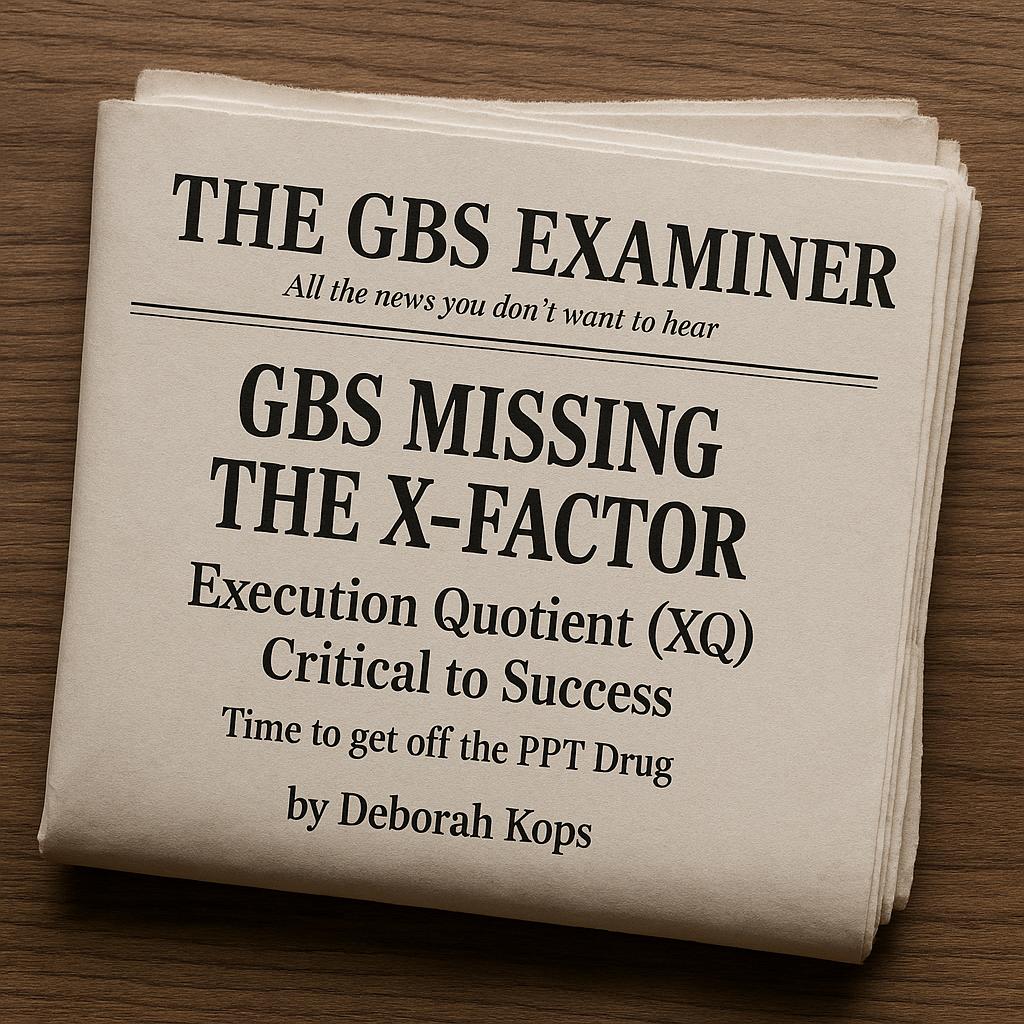GBS Lacks the X-Factor | Blog

Ever watched a Michelin-starred chef prepare for a seating? Pots and pans are gleaming, the mise en place is perfection, the sous-chefs are standing at the ready. But none of it matters until the first order drops and the oil hits the pans. Strategy, talent, and tools are just stainless-steel décor without the deliberate, disciplined motions that actually prep, cook and plate the meal, ready to serve the guests. I’d call that XQ—Execution Quotient—and it’s the difference between a late afternoon kitchen tour and a five-course culinary experience.
GBS is no different. You can have the smartest people (IQ), the most empathetic leaders (EQ), and the slickest digital tools, but if no one focuses on executing the roadmap, none of it matters. Difficult to hear but I believe execution quotient or XQ is what separates high-performing GBS organizations from PowerPoint factories.
In a high-functioning GBS, it’s not sufficient to be clever and well-liked by your stakeholders. Success actually demands a trifecta of quotients: IQ to design a model likely to perform, EQ to effectively navigate the enterprise’s complex matrix, and, critically, XQ to make it all real. Miss just one, and the whole thing wobbles. Together, they create the conditions for real, sustainably GBS performance.
Let’s unpack them.
-
- IQ Designing the model and setting forth the GBS roadmap takes smarts. High intelligence underpins GBS’s ability to structure critical thinking, solving problems, connecting the dots, and analyze with rigor is essential to improve processes, integrate technology, and make data-driven decisions across businesses, geographies and functions. Without IQ, operating model design is suboptimal, business cases fall over and technology investments don’t move the dial.
But IQ alone does not guarantee that GBS can deliver.
-
- EQ Key to GBS’s success is the ability to build trust and stakeholder alignment across the enterprise. Influencing without authority in most encounters with the business and the functions is a daily imperative. Guarding against the outright resistance, turf wars, and passive aggressive behavior that usually accompanies the imposition of a new business services platform depends on high EQ. Reading the room. Getting the team to show up and perform when the going gets tough.
Empathy creates the basis for constructive relationships but does not move the dial.
-
- XQ is the currency of credibility, consistency and reliability, the ability to consistently get things done in complex, matrixed environments. The right quantum differentiates between the best of intentions and actual GBS impact, moving from design to deployment, from roadmap to reality.
High XQ shows the enterprise that the GBS team can master complexity, coordinate cross-functionally, and deliver repeatably. It demonstrates that the GBS team knows how to manage and even scale in a matrixed environment.
Why become obsessed about XQ?
Execution separates the proverbial adults from the children. In GBS world, everyone pushes out a roadmap. Everyone claims to be “transforming” something or other—a process, a function, a model, But only the high-XQ teams actually get things across the line without collateral damage, burning bridges or shooting the model in its proverbial foot in the process. Here’s why:
-
- GBS is fundamentally a delivery business (as much as we pretend it isn’t) It doesn’t matter how brilliant the strategy is, or how aligned your PowerPoints are with the enterprise vision. If you can’t consistently execute, you lose credibility. Fast.
-
- Execution is the ultimate trust builder. Stakeholders aren’t persuaded by aspiration; they’re persuaded by invoices paid, headcount transitioned, and cycle times slashed. Repeat, repeat, repeat.
-
- XQ is critical when things go sideways (and they will). Projects will always stall. Stakeholders’ opinions will turn negative on a dime. Priorities will constantly conflict. XQ is the ability to navigate a never-ending mess and still deliver. It’s what turns chaos into outcomes.
-
- XQ is design + discipline. It’s not brute force. It’s building operating models that actively anticipate friction. Governance that clarifies. Talent that can skillfully cut through complexity. And playbooks that don’t sit on shelves.
-
- You can’t outsource XQ. You can hire consultants, buy tools, and benchmark until the cows come home. You can outsource to your heart’s delight, thinking that you’ve passed the execution ball to a third party. But ultimately GBS is on the hook.
What happens without XQ?
When XQ is low or missing, even the smartest, most emotionally intelligent GBS leaders and their teams stall out. Here’s what happens:
-
- The dashboard is as green as a Christmas tree, but no one’s happy. Metrics say “success,” but the business is still bypassing GBS, building shadow teams, change-ordering everything to death and making complaining a sport of Olympian proportions.
-
- Transformation fatigue sets in. GBS announces yet another initiative, and the inevitable eye rolls begin. Why? Because the last effort didn’t land. Or cost too much. Or took too long. Without darn good execution, any transformation simply becomes more noise.
-
- GBS becomes mired in proof-of-concept purgatory. Projects never scale. Innovation never operationalizes. Everything’s always a necessary pivot or “in progress” — but nothing ever sticks.
-
- GBS loses influence. Without execution, the model isn’t respected. Stakeholders nod politely in meetings, then do what they want, creating shadow organizations and workarounds.
-
- GBS talent disengages. All high performers want to be part of a winning team. If nothing gets over the finish line, they either check out or opt out.
-
- Leadership confidence erodes. GBS becomes the place where things almost happen. That’s usually worse than not trying at all.
XQ is the invisible muscle behind every successful GBS.
Not a buzzword. Not a mindset. A measurable, replicable ability to deliver in complexity.
You can’t fake it.
You can’t borrow it.
You can only build it—prove it—plate it—every single day.